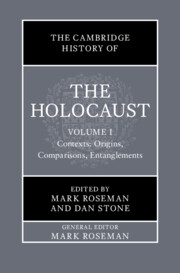Refine search
Actions for selected content:
27 results
Chapter 3 - London
- from Part I - Key Places and Events
-
-
- Book:
- Sean O'Casey in Context
- Published online:
- 23 June 2025
- Print publication:
- 10 July 2025, pp 35-44
-
- Chapter
- Export citation
Chapter 8 - Isolation, Indifference and Suspicion
-
- Book:
- Emigrant Soldiers
- Published online:
- 05 June 2025
- Print publication:
- 26 June 2025, pp 165-184
-
- Chapter
- Export citation

The Cambridge History of the Holocaust
-
- Published online:
- 16 May 2025
- Print publication:
- 12 June 2025
2 - Educational Institutions and Military Training in the 1920s and the 1930s
-
- Book:
- The Age of Youth
- Published online:
- 27 May 2025
- Print publication:
- 24 April 2025, pp 61-95
-
- Chapter
- Export citation
4 - Misreading Conservative Nationalism (1920–1945)
-
- Book:
- Cosmopolitan Nationalism in Ghana
- Published online:
- 12 December 2024
- Print publication:
- 19 December 2024, pp 158-201
-
- Chapter
- Export citation
One British Archive: Family Histories at Shulbrede Priory
-
- Journal:
- Journal of British Studies / Volume 63 / Issue 4 / October 2024
- Published online by Cambridge University Press:
- 27 November 2024, pp. 743-750
-
- Article
-
- You have access
- Open access
- HTML
- Export citation
Slovak National Communism in Interwar Czechoslovakia
-
- Journal:
- Nationalities Papers / Volume 53 / Issue 4 / July 2025
- Published online by Cambridge University Press:
- 25 September 2024, pp. 917-937
-
- Article
-
- You have access
- Open access
- HTML
- Export citation
Chapter 10 - From the ‘Great War’ to World War II
- from Part 2 - International history
-
-
- Book:
- An Introduction to International Relations
- Published online:
- 31 August 2024
- Print publication:
- 12 August 2024, pp 136-149
-
- Chapter
- Export citation
5 - A Fascist Social Justice?
-
-
- Book:
- Social Justice in Twentieth-Century Europe
- Published online:
- 29 February 2024
- Print publication:
- 07 March 2024, pp 96-115
-
- Chapter
- Export citation
13 - Exchange Rates, Tariffs and Prices in 1930s Britain
-
-
- Book:
- Keynes's <i>Economic Consequences of the Peace</i> after 100 Years
- Published online:
- 14 December 2023
- Print publication:
- 25 January 2024, pp 325-363
-
- Chapter
- Export citation
Public debt as private liquidity: the Poincaré experience (1926–1929)
-
- Journal:
- Financial History Review / Volume 30 / Issue 3 / December 2023
- Published online by Cambridge University Press:
- 22 January 2024, pp. 308-329
-
- Article
- Export citation
“Junge Mädchen” and “Daughters of the Sky”: Transatlantic Changes in the Construction of Femininity after 1930
-
- Journal:
- Central European History / Volume 57 / Issue 1 / March 2024
- Published online by Cambridge University Press:
- 20 December 2023, pp. 44-58
- Print publication:
- March 2024
-
- Article
-
- You have access
- Open access
- HTML
- Export citation
7 - The Bank of Poland and Monetary Policy during the Interwar Period
- from Part II - Specific
-
-
- Book:
- The Spread of the Modern Central Bank and Global Cooperation
- Published online:
- 02 November 2023
- Print publication:
- 16 November 2023, pp 160-196
-
- Chapter
- Export citation
9 - The Treaty of Versailles, German Disarmament and the International Order of the 1920s
- from Part II - Institutions
-
-
- Book:
- Peacemaking and International Order after the First World War
- Published online:
- 18 May 2023
- Print publication:
- 01 June 2023, pp 227-245
-
- Chapter
- Export citation
3 - The Language of Health Administrations
-
- Book:
- Statistics and the Language of Global Health
- Published online:
- 27 October 2022
- Print publication:
- 03 November 2022, pp 78-108
-
- Chapter
-
- You have access
- Open access
- HTML
- Export citation
5 - Japan and the Washington System in the Interwar Period
-
- Book:
- Ascending Order
- Published online:
- 21 July 2022
- Print publication:
- 04 August 2022, pp 136-190
-
- Chapter
- Export citation
Soviet National Autonomy in the 1920s: The Dilemmas of Ukraine’s Jewish Population
-
- Journal:
- Nationalities Papers / Volume 50 / Issue 5 / September 2022
- Published online by Cambridge University Press:
- 10 June 2022, pp. 886-905
-
- Article
-
- You have access
- Open access
- HTML
- Export citation
Contested Territories in the Short Twentieth Century: Sarah Wambaugh (1882–1955), Plebiscites, and Gender
-
- Journal:
- Nationalities Papers / Volume 50 / Issue 5 / September 2022
- Published online by Cambridge University Press:
- 07 June 2022, pp. 983-1002
-
- Article
-
- You have access
- Open access
- HTML
- Export citation
Chapter 1 - Making Romanian Germans
-
- Book:
- Migrating Memories
- Published online:
- 09 December 2021
- Print publication:
- 16 December 2021, pp 22-62
-
- Chapter
- Export citation
Introduction
-
- Book:
- Monetary War and Peace
- Published online:
- 24 February 2021
- Print publication:
- 11 March 2021, pp 1-16
-
- Chapter
-
- You have access
- HTML
- Export citation
